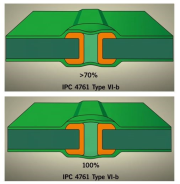 Author: Ruben Contreras, Program Manager and Field Application Engineer at NCAB Group
Author: Ruben Contreras, Program Manager and Field Application Engineer at NCAB Group
There is no such thing as a standard printed circuit board. Each PCB has a unique function for a particular product. The production process is complex and involves many different steps. At so many times I have had customers question why we need so much data. Why we ask so many questions before we manufacture a circuit board. Often times I get, “My other suppliers don’t ask so many questions.” And I reply with, “And what is that suppliers’ quality rate?” Yes, I know these questions may be an annoyance, especially when you finally have a board designed and are ready to have it built for a product. But I assure you, there is a reason we ask questions, and require specifications.
For PCB designers and manufacturers, IPC standards are the ultimate guide. They establish the basic requirements as well as acceptability criteria for the finished product. IPC has done very well creating a set of standards as a baseline all of us in the industry can work with. But it’s also important to have a set of standards and product specifications based on experience, which in many instances is above the requirements of IPC. Why, you may ask? Basically it comes down to reliability. It’s important to work with a partner that can deliver an exceptional product and demand more than what the industry is requesting.
 One specification that we implement on all our PCBs, regardless if they are for a remote car toy or a medical ventilator, is all boards must have a 25 micron nominal hole plating. This is a class 3 requirement per IPC, but we have found it should be mandatory for all of PCBs. This ensures that even when a design is for a class 2 board, class 3 plating will be implemented for an added layer of protection on the end product. When boards go through thermal cycling there is a risk that the plating will crack and create an open on the board. Having the extra plating in the hole barrel will make for a board that will have better yields through the thermal cycling process — not just during assembly, but also in the field.
One specification that we implement on all our PCBs, regardless if they are for a remote car toy or a medical ventilator, is all boards must have a 25 micron nominal hole plating. This is a class 3 requirement per IPC, but we have found it should be mandatory for all of PCBs. This ensures that even when a design is for a class 2 board, class 3 plating will be implemented for an added layer of protection on the end product. When boards go through thermal cycling there is a risk that the plating will crack and create an open on the board. Having the extra plating in the hole barrel will make for a board that will have better yields through the thermal cycling process — not just during assembly, but also in the field.
Another requirement we have determined produces reliability is to not allow for any open circuit repairs on boards. Our many years of experience have taught us that when circuits are repaired there is always a risk that the repairs may fail. Many times the failure does not happen until the boards are out in the field, making the failure a very costly service repair.
 A minimum depth for via fills should be established in specifications. At the moment IPC does not specify or provide a requirement for the depth or amount of via fill in standard solder mask ink plugging. Of course the target level for filling the hole is 100%, but our manufacturing experience tells us there are tolerances within the processes. Our minimum target of 70% of filling level is aimed to ensure optimum functionality and reliability on a repeatable level. Research and experience has shown that when the via fill does not cover enough hole surface there is a risk of chemical entrapment either from PCB manufacturing process or from assembly. During the lifecycle of an assembled board, no dust or humidity can penetrate into properly filled via holes which provides long-term reliability. Our established minimum of 70% of the hole surface coverage, makes chemical entrapment practically non-existent.
A minimum depth for via fills should be established in specifications. At the moment IPC does not specify or provide a requirement for the depth or amount of via fill in standard solder mask ink plugging. Of course the target level for filling the hole is 100%, but our manufacturing experience tells us there are tolerances within the processes. Our minimum target of 70% of filling level is aimed to ensure optimum functionality and reliability on a repeatable level. Research and experience has shown that when the via fill does not cover enough hole surface there is a risk of chemical entrapment either from PCB manufacturing process or from assembly. During the lifecycle of an assembled board, no dust or humidity can penetrate into properly filled via holes which provides long-term reliability. Our established minimum of 70% of the hole surface coverage, makes chemical entrapment practically non-existent.
When boards require an array, a no X-out requirement should be established. This makes for a very efficient assembly without having to worry about separating panels with X-outs and running them separately to avoid component placement on defective boards.
 IPC does not specify the thickness of the solder mask, but the thickness can affect the product’s quality. Thin deposits of solder mask can lead to problems with adhesion of the ink to the surface, resistance to solvents and hardness, all of which can cause solder mask to peel away from the board, and poor insulation characteristics due to the thin deposits can lead to short circuit through unwanted electrical continuity. Soldering problems can also be caused by an excess of solder mask. If the solder mask is too thick between the board and component, then this can cause components to sit improperly during assembly process. This is why having a defined range of solder mask thickness provides more reliability and less risk of failure.
IPC does not specify the thickness of the solder mask, but the thickness can affect the product’s quality. Thin deposits of solder mask can lead to problems with adhesion of the ink to the surface, resistance to solvents and hardness, all of which can cause solder mask to peel away from the board, and poor insulation characteristics due to the thin deposits can lead to short circuit through unwanted electrical continuity. Soldering problems can also be caused by an excess of solder mask. If the solder mask is too thick between the board and component, then this can cause components to sit improperly during assembly process. This is why having a defined range of solder mask thickness provides more reliability and less risk of failure.
Specifications should not allow any pattern modification without customer consent. We have all heard the stories from designers of what happens when a fabricator makes modifications to their designs without their approval. As part of a very thorough pre-production engineering (PPE), the PCB producer should address any required modification with the customer prior to making any changes.
Some of these requirements will add cost to the price of the PCB. But ultimately, any additional costs will pay for themselves. Our experience has shown us that by implementing these specifications, and considering the savings of not having failures, or having to rework assemblies, over time it ends up being the lowest total cost.
Should you want to discuss this topic further, please contact your local Technical Manager, Steve Shipway using the details below:
Steve Shipway
Technical Manager
Direct +44 01380 736163
Mobile +44 7979 854092

